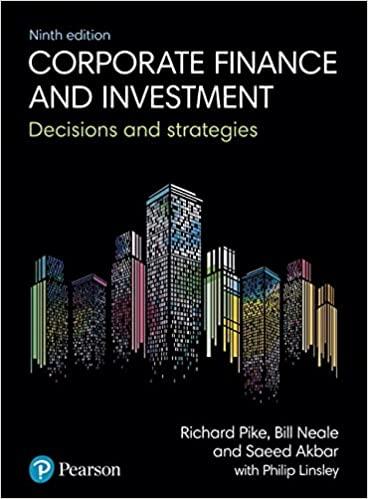Amalgamated Effluents plc, a chemical company currently in legal difficulties over its pollution record, is considering a
Question:
Amalgamated Effluents plc, a chemical company currently in legal difficulties over its pollution record, is considering a proposal to acquire new equipment to improve waste generation. The equipment would cost £500,000 and have a working life of four years. At the end of Year 4, the disposal value of the equipment is expected to be
£50,000. The machine is expected to generate incremental cash flows of £200,000 for each of the four years.
Amalgamated can acquire the equipment in two ways:
(a) Outright purchase via a four-year bank loan at a pre-tax interest cost of 7 per cent.
(b) A financial lease with rentals of £70,000 at the end of each of the four years.
Amalgamated is presently ungeared. Its shareholders seek a return of 10 per cent after allowing for all taxes.
Corporation Tax is paid at 30 per cent with no tax delay. If the equipment is purchased, a 25 per cent writing-down allowance (reducing balance) is available.
Required Should Amalgamated acquire the equipment and, if so, how should it be financed?
8 LEE is a manufacturing entity located in Newland, a country with the dollar ($) as its currency. LOR is a leasing entity that is also located in Newland.
LEE plans to replace a key piece of machinery and is initially considering the following two approaches:
Alternative 1 – purchase the machinery, financed by borrowing for a five-year term.
Alternative 2 – lease the machinery from LOR on a five-year operating lease.
The machinery and maintenance costs The machinery has a useful life of approximately 10 years, but LEE is aware that the industry is facing a period of intense competition and the machinery may not be needed in five years’ time. It would cost LEE $5,000 to buy the machinery, but LOR has greater purchasing power and could acquire the machinery for $4,000.
Maintenance costs are estimated to be $60 in each of Years 1 to 3 and $100 in each of Years 4 and 5, arising at the end of the year.
Alternative 1 – purchase financed by borrowing for a five-year term $ interbank borrowing rates in Newland are currently 5.5 per cent per annum. LEE can borrow at interbank rates plus a margin of 1.7 per cent and expects $ interbank rates to remain constant over the five-year period. It has estimated that the machinery could be sold for $2,000 at the end of five years.
Alternative 2 – five-year operating lease Under the operating lease, LOR would be responsible for maintenance costs and would charge LEE lease rentals of $850 annually in advance for five years.
LOR knows that LEE is keen to lease rather than buy the machine and wants to take advantage of this position by increasing the rentals on the operating lease. However, it does not want to lose LEE’s custom and requires advice on how high a lease rental LEE would be likely to accept.
Tax regulations Newland’s tax rules for operating leases give the lessor tax depreciation allowances on the asset and give the lessee full tax relief on the lease payments. Tax depreciation allowances are available to the purchaser of a business asset at 25 per cent per annum on a reducing balance basis. The business tax rate is 30 per cent and tax should be assumed to arise at the end of each year and be paid one year later.
Alternative 3 – late proposal by production manager During the evaluation process for Alternatives 1 and 2, the production manager suggested that another lease structure should also be considered, to be referred to as ‘Alternative 3’. No figures are available at present to enable a numerical evaluation to be carried out for Alternative
Step by Step Answer:






